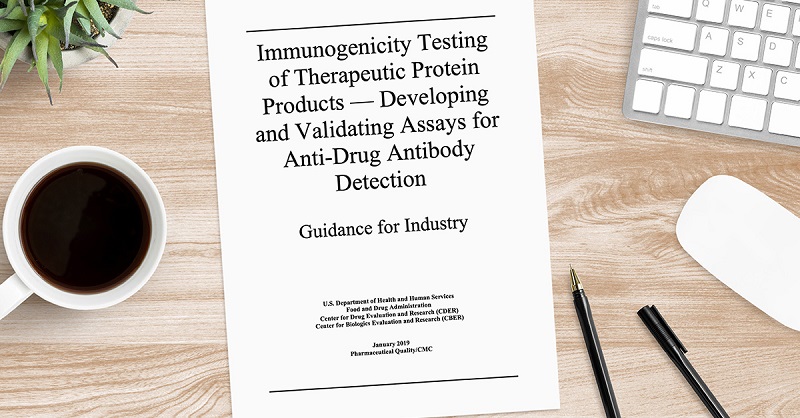You may have seen that in January, the FDA released new guidance designed to facilitate the development and validation of assays for the detection of anti-drug antibodies (ADAs) supporting immunogenicity testing of therapeutic protein products during clinical trials. The risks to patients that have an ADA-generating immune response can be highly variable, from causing no measurable effect to life-threatening harm, and therefore as an industry we agree that understanding the incidence of ADA induction or any implications of ADA responses affecting pharmacokinetics (PK), pharmacodynamics (PD), safety, or efficacy is critical to clinical development programs.
That said, the field of immunogenicity is ever-evolving as we learn more about how to accurately evaluate and manage unwanted drug-induced immune responses, and I was pleased to see that the FDA’s new draft guidance includes some significant and needed revisions and clarifications. I summarize several below:
Lifecycle Management Approach to Immunogenicity
To ensure all data relevant to the immunogenicity assessment of a therapeutic biologic can be accessed and cross-referenced in one location, the FDA has recommended the use of an integrated immunogenicity summary report that would span through IND stages into the BLA and to post-approval. Sponsors should begin populating the report early in the clinical development phase and update it at regular intervals with stage-appropriate information as the clinical program progresses. The FDA recommends the integrated summary of immunogenicity include:
- Immunogenicity Risk Assessment: to summarize product quality-related factors, subject-related factors, and trial designed-related factors that may impact immunogenic potential and the sponsor’s strategies for managing immunogenic responses.
- Tiered Bioanalytical Strategy and Assay Validation Summaries: of the immunogenicity assessment strategies used during each phase of the clinical program, including characterization for the various methods that were developed throughout the program.
- Clinical Study Design and Detailed Immunogenicity Sampling Plans: for all clinical studies that had an immunogenicity assessment performed, including sampling time points for immunogenicity and PK of the therapeutic biologic if applicable.
- Clinical Immunogenicity Data Analysis: summarizing the results of immunogenicity analyses for all clinical studies having an immunogenicity component, including the results of linear or non-linear correlation analyses between ADA status and titers with PK, PD, efficacy, and safety data. In this section, sponsors should also include drug levels measured in samples tested for ADA and address the impact that any pre-existing or treatment-induced antibodies have on the product’s safety and efficacy profile.
- Conclusions and Risk Evaluation and Mitigation Strategies (REMS): to conclude how the therapeutic biologic’s immunogenicity affects its safety and efficacy for the subject population evaluated. Plans for how immunogenicity will be monitored in the post-marketing stage, including an assay requalification schedule and methods for assay transfer to contract testing laboratories, should also be described.
This lifecycle management approach is key to understanding the effects of immune responses to a therapeutic protein product over time and to confirming the appropriate steps are taken at each phase to both assess and mitigate risk to product efficacy and patient safety.
Definition and Assessment of Specificity/Selectivity
The FDA’s guidance also provides revised definitions for the assessment of specificity and selectivity of ADA assays. In the case of specificity, FDA notes that demonstrating the specificity of antibody responses to mAb, Fc-fusion proteins, and Ig-fusion proteins poses challenges because of the high concentration of Ig in human serum, and therefore assays should specifically detect anti-mAb antibodies but not the mAb product itself, soluble drug target, non-specific endogenous antibodies, or antibody reagents used in the assay. In the case of selectivity of an ADA assay, FDA has defined this as the assay’s ability to identify ADAs specific to the therapeutic protein product in the presence of other components in the sample. Most assay matrices contain significant amounts of proteins of various sizes and charges, and therefore results may be affected by interference from the matrix or onboard therapeutic protein product. It is important to consider how the sample matrix can affect assay performance.
Assessment of Domain Specificity and Pre-existing Antibodies
I was also glad to see the new guidance provide clarifications about the assessment of domain specificity, recommending that sponsors direct initial screening and confirmatory tests against the whole therapeutic protein product. The FDA notes that multi-domain therapeutic protein products may require development of multiple assays to measure immune responses to different domains of the molecules. For example, understanding the risk of ADAs against therapeutic protein products with modifications such as PEGylation would require development of two assays: one to determine the specificity of ADA for the protein component and one for the modification to the therapeutic protein product. Also provided in the guidance was clarification on pre-existing antibodies and the possible need to discriminate between antibody isotypes and IgG subclasses.
It is exciting and inspiring to see the progress being made in the area of immunogenicity as we collectively increase our understanding of potential immune responses against today’s innovative therapeutic biologics. This latest guidance will help to serve us all in our quest to deliver safe, effective therapies to patients in need.
